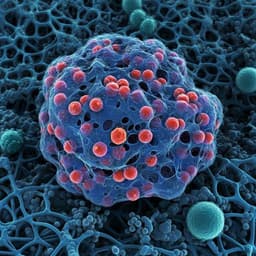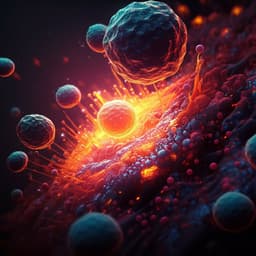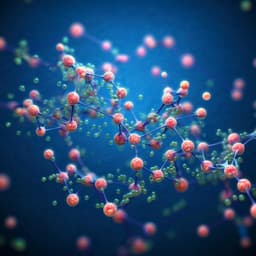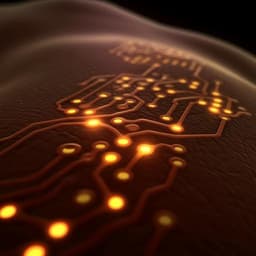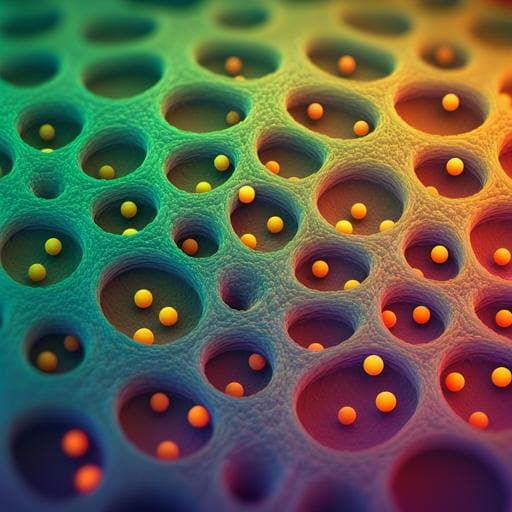
Medicine and Health
Ultra-durable cell-free bioactive hydrogel with fast shape memory and on-demand drug release for cartilage regeneration
Y. Yang, X. Zhao, et al.
Discover how Yuxuan Yang and colleagues have pioneered a cell-free hydrogel scaffold for cartilage regeneration through an innovative polyaddition reaction. This groundbreaking research not only showcases impressive mechanical properties and drug release capabilities but also highlights the hydrogel's potential to promote stem cell migration and chondrocyte differentiation, leading to effective cartilage regeneration in vivo.
~3 min • Beginner • English
Introduction
The study addresses the clinical challenge of regenerating articular cartilage in osteoarthritis (OA), a highly prevalent disease with limited intrinsic healing due to avascularity and a harsh biomechanical environment. Existing treatments (microfracture, mosaicplasty, transplantation, medications) are invasive and often yield limited outcomes, sometimes culminating in joint replacement. Cell-laden hydrogel scaffolds can mimic ECM and deliver cells or drugs but often suffer from poor mechanical integrity, especially under arthroscopic delivery, and raise concerns such as cell survival, immune rejection, complex culture, decreased post-transplant regenerative capacity, and ethical issues. A cell-homing strategy that recruits endogenous mesenchymal stem cells (MSCs) from subchondral bone is attractive, but current methods using cytokines/peptides are costly and may disturb bone homeostasis or cause calcification. The authors hypothesize that a cell-free hydrogel combining tannic acid (TA) to modulate inflammation/oxidative stress and recruit MSCs, with kartogenin (KGN) to induce chondrogenic differentiation, and reinforced by multiple hydrogen bonds to achieve high mechanical durability and shape-memory for minimally invasive delivery, can enable full-thickness cartilage regeneration.
Literature Review
Prior work shows cell-laden hydrogels support cartilage regeneration but often lack sufficient mechanical strength and structural stability for arthroscopy. Stem-cell therapies face survival, immune, and ethical limitations. Endogenous cell recruitment using cytokines (e.g., TGF-β, SDF-1α) or peptides can be effective but costly and potentially disruptive to subchondral bone homeostasis or may lead to calcification. Mechanical properties of scaffolds strongly influence chondrogenesis by affecting cell mechanobiology. TA, a natural polyphenol, can promote migration in multiple cell types and provides anti-inflammatory, antioxidant, and antibacterial activities. KGN promotes MSC chondrogenic differentiation at appropriate doses. Previous hydrogels (natural/synthetic like alginate, chitosan, PEG) often underperform mechanically relative to cartilage. Hence, a hydrogel integrating TA-mediated bioactivity for cell homing and microenvironment modulation, KGN for differentiation, and a hydrogen-bond reinforced network for toughness and shape memory addresses identified gaps.
Methodology
Materials and synthesis: A polyurethane-based polymer (PMI) was synthesized by polyaddition (polycondensation) of methylene diphenyl 4,4-diisocyanate (MDI), imidazolidinyl urea (IU; hydrogen-bond reinforcing factor), and poly(ethylene glycol) (PEG; Mn ~6000) using DBTDL catalyst. Kartogenin (KGN, 2 mg/mL) was mixed into PMI solution, solvent-evaporated at 70 °C to form PKG film. PMI and PKG films were swollen in water to obtain hydrogels (PMI, PKG). Films were then immersed in 5% w/v tannic acid (TA) to form PTA and PTK hydrogels via additional hydrogen bonding with TA. Characterization: FT-IR (Thermo Nicolet 6700) identified shifts in TA C=O and O–H stretching (1637→1714 cm−1; 3285→3326 cm−1), indicating hydrogen bonding. SEM (Hitachi SU3500) of freeze-dried, gold-sputtered samples assessed porous microstructures and pore size differences reflecting crosslinking density. Mechanical testing: Tensile tests (CMT-1503, SUST Inc.) at room temperature, 100% humidity, sample size 16×4×1 mm, strain rate 50 mm/min. Fatigue tests: successive loading–unloading between 0–100% strain up to 28,000 cycles; stress retention quantified at multiple cycle counts. Compression compared to porcine cartilage (supplementary). Adhesion: Lap-shear on pig costal cartilage (15×40 mm substrates); hydrogels (1×1 cm) applied; shear at 50 mm/min; strength calculated (n=3). Shape-memory: Hydrogel strips (30 mm length) temporarily deformed (helix/coil) at 4 °C; recovery observed at 37 °C, 95% humidity; central angle and diameter tracked; recovery ratio measured over 9 cycles. Drug release: Discs (8 mm diameter, 1 mm thick) in 40 mL PBS (37 °C, 60 rpm), media changed daily. TA quantified by UV–Vis at 276 nm; KGN by HPLC (Shimadzu SPD-M40; WondaSil C18-WR 250×4.6 mm, 5 µm; detection at 270 nm). Biocompatibility: In vitro cytotoxicity (MTT) and Live/Dead (calcein/PI) on rat BMSCs using hydrogel extracts (50 mg/mL) at 24 and 96 h; hemolysis assay; in vivo subcutaneous implantation in SD rats to assess organ histology at 2 months and local H&E at 7 and 30 days; in vivo degradation mass loss over time. Bioactivities: Antioxidant via DPPH scavenging (0.5–10 mg/mL PTK; PMI 10 mg/mL) measured at 517 nm. Anti-inflammation: LPS (10 µg/mL) stimulated BMSCs treated with hydrogel extracts (50 mg/mL); IL-6 quantified by ELISA. Antibacterial: Against E. coli and S. aureus at 10^8 CFU/mL; treatments with PBS, KGN (100 mM), TA (5 mg/mL), and hydrogels (10 mg/mL) for 12 h; CFU counting; Live/Dead BacLight staining; SEM of bacterial morphology after fixation/dehydration. Cell homing/migration: In vitro scratch assay imaging at 0 and 24 h, ImageJ quantification of uncovered area; Transwell migration (8 µm) with hydrogel-conditioned medium or TA; crystal violet staining and counting. Chondrogenic differentiation in vitro: BMSC pellet culture (2.5×10^5 cells), co-cultured 21 days with media conditioned by PMI or PTK (10 mg/mL), Alcian blue staining. In vivo cartilage regeneration: SD rat full-thickness trochlear groove defects (2 mm diameter, 2 mm depth) in both knees; right defects filled with PMI, PTA, PKG, or PTK discs (2×2 mm; PTA/PTK contained 2.2 mg TA; PTK ~0.008 mg KGN); left untreated controls. Evaluation at 8 weeks: gross imaging and ICRS macroscopic score; load-bearing test (weight-bearing capacity); histology (H&E, toluidine blue, Safranin O/Fast Green), immunohistochemistry (COL II; also ALP and COL I in supplement); ICRS visual histological and OARSI scores; defect distances and ImageJ-based COL II intensity. Molecular assays: RT-PCR for ACAN, COL II, SOX9 (IQ5, Bio-Rad; 1 µg RNA to cDNA), Western blot of ACAN, COL II, SOX9 normalized to β-actin. Statistics: n as indicated (generally n=3), one-way ANOVA; p<0.05 significant.
Key Findings
- Mechanical performance: TA-reinforced hydrogels (PTA/PTK) achieved tensile fracture stress ~1.1 MPa. PTK withstood 28,000 loading–unloading cycles with >90% initial stress retention through 20,000 cycles; PMI failed ~1,600 cycles. Adhesion to cartilage reached ~19.2 kPa. Shape memory: temporary helix/coil shapes recovered within 30 s at 37 °C; diameter and central angle restored rapidly; recovery ratio ~100% after 9 cycles.
- Drug release: TA exhibited burst and staged release (≈40% in first 6 h; ≈86% within 1 week), then sustained; KGN released continuously for 30 days and ≈60% by 60 days.
- Biocompatibility: >90% BMSC viability across PMI, PKG, PTA, PTK; negligible hemolysis; no organ toxicity or local inflammatory accumulation in vivo; PTK degraded over ~60 days.
- Antioxidant/anti-inflammatory/antibacterial: DPPH scavenging by PTK was concentration-dependent, >84% at 1 mg/mL; PMI ~5.1%. LPS-induced IL-6 reduced ~5-fold with PTA/PTK (comparable to TA alone), while control/PMI/PKG remained high. Antibacterial efficacy: PTK achieved ~93% (E. coli) and ~98% (S. aureus) killing after 12 h; TA/PTA similar; KGN/PMI/PKG ineffective.
- Cell homing and migration: Scratch assay showed uncovered area reduced by ~3.6–3.9× in TA/PTA/PTK vs control; minimal effect with PMI/PKG. Transwell migration increased ~6.4–6.9× in TA/PTA/PTK vs control, indicating TA-driven chemotaxis. PTK-conditioned medium promoted larger BMSC cartilage pellets than control/PMI.
- In vivo regeneration: Grossly, PTK produced smooth hyaline-like cartilage contiguous with native tissue; PTA/PKG showed partial repair with irregular surfaces; PMI/control poor repair. ICRS macroscopic score for PTK ≈11.3 (native 12), 2.9× PMI and 5.7× control. Weight-bearing recovery with PTK ~98.1% of healthy limb. Histology: PTK showed continuous, thick cartilage with robust proteoglycan (toluidine blue) and Safranin O-positive cartilage distinct from subchondral bone, indicating minimal calcification. COL II IHC: strongest, continuous staining in PTK; relative COL II intensity increased by 22.1× vs control (and 6.5× vs PMI; 2.3× vs PKG; 3.2× vs PTA). ICRS visual histology score highest (11.3) and OARSI lowest (0.6) for PTK; no cartilage fracture in PTK.
- Molecular markers: RT-PCR showed ACAN, COL II, SOX9 expression in PTK were ~59.7×, 13.3×, and 4.7× control, respectively; PKG elevated COL II and SOX9 ~3.6× and ~3.5×. Western blot semi-quantification: ACAN ~52.6×, COL II ~2.7×, SOX9 ~3.8× vs control in PTK.
Discussion
The hydrogel integrates a mechanically robust, hydrogen-bonded polyurethane network with bioactive TA and KGN to realize a cell-free strategy for cartilage repair. High toughness, fatigue resistance, adhesion, and fast shape memory enable minimally invasive delivery and stable fixation under joint loading, fostering a regenerative niche. Stage-dependent release aligns with the healing cascade: initial TA burst modulates inflammation, scavenges ROS, provides antibacterial protection, and recruits endogenous BMSCs; sustained KGN release then induces chondrogenic differentiation, driving hyaline cartilage formation. In vitro assays confirm TA-driven chemotaxis and antioxidative/anti-inflammatory effects; in vivo, PTK yields near-native macroscopic appearance, superior functional recovery, favorable histological scores (ICRS, OARSI), strong COL II deposition, and upregulated chondrogenic gene/protein expression. These results directly address limitations of prior hydrogels (insufficient mechanics, reliance on exogenous cells/cytokines) and demonstrate that a durable, shape-memory, bioactive cell-free scaffold can orchestrate endogenous repair for full-thickness cartilage regeneration.
Conclusion
This work presents a cell-free, hydrogen-bond crosslinked hydrogel (PTK) co-loaded with tannic acid and kartogenin that combines ultra-durable mechanics, fast shape memory, strong tissue adhesion, and multifaceted bioactivity (antioxidant, anti-inflammatory, antibacterial). The hydrogel sequentially recruits endogenous BMSCs and promotes their chondrogenic differentiation, achieving near-native cartilage regeneration in a rat defect model with excellent macroscopic, functional, histological, and molecular outcomes. Future directions include tuning TA release to mitigate initial burst and optimize chemotaxis, engineering hydrogen-bond interactions to modulate transition temperature and control shape recovery rate for endoscopic handling, validating efficacy and minimally invasive delivery in larger animal models, and developing suitable 3D-printing strategies to fabricate anatomically precise constructs without compromising TA bioactivity.
Limitations
- Initial burst release of TA (~40% within 6 h; ~40% within first 4 h noted) may limit sustained homing efficacy; release kinetics need refinement.
- Minimally invasive arthroscopic delivery was not demonstrated in rats due to joint size constraints; larger animal studies are required to validate translational deployment and shape-memory handling.
- Challenges for 3D printing: PMI/PKG injection into TA forms unstable dimensions; TA may oxidize at elevated temperatures (e.g., FDM), potentially impairing bioactivity; suitable printing methods must be established.
- Mechanical properties, while high and fatigue-resistant, remained lower than native porcine cartilage in fracture/compression (supplementary), which may influence performance under extreme loads.
Related Publications
Explore these studies to deepen your understanding of the subject.



